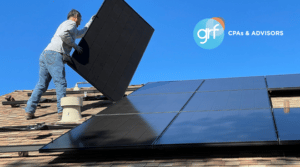December 20, 2022

#1 Mortgage Interest Deductions
If you have a mortgage on your home, through 2025 under the Tax Cuts and Jobs Act (TCJA), you’re generally allowed to deduct interest on only up to $750,000 of mortgage debt incurred to buy or improve a first or second residence. This limit applies to “home acquisition indebtedness” incurred after December 15, 2017, with some limited exceptions. (For married individuals who file separately, the home acquisition indebtedness limit is $375,000 for 2018 through 2025.)
Under pre-TCJA law, you could deduct interest on up to $1 million of home acquisition indebtedness (or $500,000 for those who use married filing separate status).
The TCJA grandfathers in existing home mortgage debt under the old rules. That is, the new law doesn’t affect home acquisition indebtedness of up to $1 million (or $500,000 for married-separate filers) that was taken out:
- Before December 16, 2017, or
- Under a binding contract that was in effect before December 16, 2017, so long as the home purchase closed before April 1, 2018.
Under another grandfather provision, the previous home acquisition indebtedness limits of $1 million (or $500,000 for married-separate filers) continue to apply to home acquisition indebtedness that was taken out before December 16, 2017, and then refinanced during the period extending from December 16, 2017, through 2025. But the grandfather provision applies only to the extent that the initial principal balance of the new loan doesn’t exceed the principal balance of the old loan at the time of the refinancing.
In addition, for 2018 through 2025, the TCJA effectively limits the home equity interest deduction to debt that would qualify for the home mortgage interest deduction. (For married individuals who file separately, this limit is $50,000 for 2018 through 2025.) Under pre-TCJA law, interest was deductible on up to $100,000 of home equity debt used for any purpose, such as to pay off credit card debt or to buy a car.
Home equity debt is the usual method of borrowing to finance home improvements if you don’t have cash on hand to pay for them. Tax advantage: If you borrow money through a home equity loan or line of credit and use the proceeds for significant home improvements, the debt can be treated as an acquisition debt instead of a home equity debt, because it’s incurred to “substantially improve” a qualified residence. Accordingly, you may add the mortgage interest to your deductible total if you itemize deductions. The IRS officially gave this technique its stamp of approval in IRS Release No. 2018-32.
#2 Adjustment to Basis
The home sale gain exclusion is one of the biggest and best tax breaks on the books. If you sell a home that you’ve owned and used as your principal residence at least two out of the last five years, you may exclude from tax up to $250,000 of gain ($500,000 for married people who file joint tax returns). To qualify for the larger $500,000 joint-filer exclusion, at least one spouse must pass the ownership test and both spouses must pass the use test. Your principal residence for the year is the place where you spend the majority of time during that year.
In the past, the home sale gain exclusion frequently covered the full amount of gain, but the recent spike in housing prices in many areas could result in a portion of your gain being subject to tax. Fortunately, you can adjust your basis for calculating gain to reflect home improvements, thereby reducing (or even eliminating) any taxable gain.
For example, say Carol and Mike bought a home for $200,000 shortly after they were married. In 2022, they sold the property for $800,000. Normally, this would generate a gain of $600,000 ($800,000 minus $200,000 of tax basis). And the excess $100,000 above the exclusion amount would be taxable ($600,000 minus $500,000).
However, Carol and Mike made $150,000 in home improvements over the years. The tax code allows them to adjust their tax basis for the home improvements, so their adjusted tax basis is $350,000 ($200,000 plus $150,000). As a result, their gain on the sale is only $450,000 ($800,000 minus $350,000). This is less than the home sale gain exclusion of $500,000 for married couples who file joint returns, which means the entire gain is tax-free.
Important: Keeping good records is essential. You must be able to back up your home improvement amounts with receipts or other documentation in case the IRS challenges them.
#3 Medically Necessary Improvements
If you itemize deductions in 2023, you can deduct qualified unreimbursed medical expenses above 7.5% of your adjusted gross income (AGI) for the year. For example, if your AGI is $100,000, your annual deduction equals any amount greater than $7,500 (7.5% of $100,000). If you spend $8,000 in qualified expenses, your annual deduction is limited to $500 ($8,000 minus $7,500).
For this purpose, a qualified expense must be incurred primarily for the prevention or alleviation of a physical or mental defect or illness. On the other hand, an expense that’s merely beneficial to your general health isn’t deductible.
Important: If you make a home improvement that’s medically necessary, you can deduct the amount above the resulting increase in the home’s value.
For example, suppose you install an in-ground pool based on a physician’s advice to accommodate swimming by a spouse with a heart condition. The pool costs $25,000 and increases your home’s value by $15,000, so you can add $10,000 to your qualified medical expenses. This can increase an existing medical expense deduction (if you’re already above the AGI threshold) — or it may be enough to put you over the AGI threshold for the year. When possible, try to bunch medical expenses in a tax year in which you expect to clear the annual AGI threshold.
#4 Residential Energy Credits
The new Inflation Reduction Act (IRA) enhances two tax credits for implementing energy-saving measures in your home. These changes are generally effective in 2023. Here’s a brief overview.
First, the IRA extends the “residential clean energy credit” through 2034. It was previously scheduled to expire after 2023. This credit is available for installing solar panels or other equipment to harness renewable energy sources like wind, geothermal, biomass or fuel cell energy. Besides the extension, the IRA also boosts the credit amount for 2023 to 30% from a 23% rate, in addition to other technical changes.
Second, the IRA includes numerous revisions to the “energy efficient home improvement credit.” Notably, it hikes the credit from 10% to 30%. It also replaces a lifetime credit limit of $500 with an annual dollar cap of $1,200 and imposes dollar caps for certain specific items. A special $2,000 limit applies to electric or natural gas heat pump water heaters, electric or natural gas heat pumps, and biomass stoves and boilers.
GRF Can Help
Home improvements can provide sizable tax savings if you follow the IRS blueprint. But, beware: Nailing down the tax breaks isn’t a do-it-yourself project. Contact your CPA for professional guidance, or reach out to us at the contact info below.
